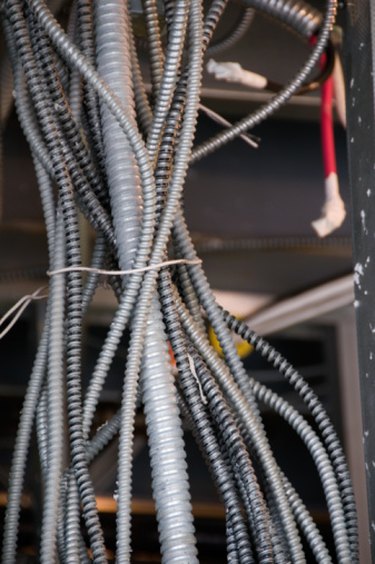
The Ohm is an SI unit of electrical resistance. It is named after German physicist Georg Simon Ohm, who proposed the fundamental electrical relationship now known as Ohm's Law: Current equals voltage divided by resistance, or I = V/R. Ohms are used to measure the continuity of a circuit. A circuit through which electricity is able to travel has continuity; a circuit through which electricity is unable to travel does not have continuity. When an electrician or home handyman wishes to measure the continuity, or resistance of a circuit, he typically uses a multimeter, also called a multi-tester or volt ohm meter.
Step 1
Familiarize yourself with your multimeter. A multimeter consists of three functional parts: a dial or LCD screen, a rotary knob and two wired probes, one red and one black. A dial indicates an analog multimeter; an LCD screen indicates a digital multimeter.
Video of the Day
Step 2
Understand the markings along the outer perimeter of the multimeter knob. These markings identify the settings of your multimeter. The Ohms setting will be labeled "Ohms" or it will be labeled with a symbol that looks like an upside-down horseshoe. If there is only one Ohms setting, your multimeter is a multi-ranging meter.
Step 3
Turn the rotary knob on your multi-ranging multimeter until the arrow or notch on the knob is opposite the word "Ohms" or the upside-down horseshoe symbol. This setting will work at all resistance levels.
Step 4
Turn the rotary knob on your non-multi-ranging multimeter until the arrow or notch on the knob is opposite the lowest of the numbers grouped under the word "Ohms" or the upside-down horseshoe symbol. The numbers are typically 200, 2K, 20K, 200K, 2M and 20M; "K" stands for one thousand Ohms and "M" stands for one million Ohms. Use the lowest setting, 200 Ohms, to test for continuity.
Step 5
Identify a port on the front of your multimeter labeled with a "V" or "Ohms" or the upside-down horseshoe symbol. Plug the cord of the red removable multimeter probe into this port. Identify a port on the front of your multimeter labeled "COM" or "Ground" or "GND" and plug the black removable probe into this port. If your multimeter does not have removable probes, omit this step.
Step 6
Take the red probe of your multimeter in one hand, the black probe in the other hand, and hold the probes apart.
Step 7
Observe the indicator needle of your analog multimeter while the metal probes are apart. The needle will deflect to the far left-hand side of the dial to a sideways figure-eight symbol on the top scale of the dial. This indicates infinite resistance, or noncontinuity.
Step 8
Observe the LCD screen of your digital multimeter while the metal probes are apart. The screen will read "OL" or "1" or "-1," or it may display dashed lines. This indicates non-continuity.
Step 9
Touch the metal points of the probes together.
Step 10
Observe the indicator needle of your analog multimeter while the metal probes are touching. The needle should deflect to the right-hand side of the indicator and point to zero on the top scale of the dial. If it does not point to zero, turn the small, knurled adjusting knob on the side of your multi-tester to align the needle with zero. Your analog multimeter is ready for use.
Tip
Always keep fresh batteries in your multimeter to prevent false readings.
Warning
Never measure resistance in a circuit without first disconnecting the circuit from its power supply.
Video of the Day